Bill Nguyen – Eyes (I), Minds (Mine) & (Yours)
 |
Review: Hoang Minh Duc’s “Longan” at Nha San
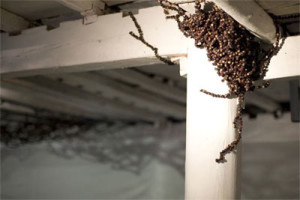
Nha San is a strange place. It functions like a labyrinth, both physically and psychologically. If you are not familiar with the area in which Nha San is situated, you will easily get lost trying to find it. Even if you are familiar with the area, you will never believe something like Nha San ever exists in Hanoi. Located in a busy neighbourhood west of town and surrounded by apartment blocks after apartment blocks, Nha San seems concealed and distant at first. However once you step inside, you will enter a whole different world, so intriguing that you will never want to leave.
The story of Nha San started in 1992 when artist Nguyen Manh Duc brought a ‘nha san’ [1] from the Muong ethic minority from Hoa Binh province back to Hanoi, and introduced it to the art scene here. Nha San doesn’t have just one role or purpose; it is everything and anything in between. Partly a living space for Manh Duc and his family, a studio for producing statues, a storeroom for rare antiques; in the last 10 years or so, Nha San has also become a gallery, an art site, and a meeting place for both local and international artists, art critics and art-lovers. If one describes this place as ‘unique’, ‘extraordinary’ or ‘spectacular’, they must be understating not only its physical location, but also its mental status within the Hanoi’s art scene. Having been titled “Vietnam’s first experimental art gallery” [2] and “the capital’s most active centres for installation and performance art” [3], to me, Nha San is unarguably more charming and admiring than that.
However, a place of such strong characteristics comes with its drawbacks, too. Occasionally, Nha San can appear so overpowering that the artworks exhibited here tend to become less significant and even lost. A gallery space is supposed to be neutral; its role is to be a blank canvas. Nha San is in the opposite position – there is always something to be discovered and to be appreciated here. In other words, our attention is often (mis)led back to Nha San – its structures, scenery; its people, the objects and furniture it contains – and not on the artworks. Therefore for an exhibition to be successful, Nha San needs to be selective of the kind of works that could or should be shown in the space. The artist themselves must also realize this fact and work closely with (and at) Nha San. Hoang Minh Duc has managed to do just that. The fact that his first solo exhibition, entitled ‘Longan’, is held at Nha San speaks volume about this artist.
—
The exhibition comprises a number of site-specific sculptures and installations. As the title suggests, each of these sculptures/installations are made from longan seeds – hundreds of them, joined together, spread around the space. This ordinary and non-materialistic medium has a significant and sentimental value to the artist. The reason, he states, comes from his childhood upbringing filled with memories of the longan: having to work and make his own fun out of whatever he could find on the fields, and having to collect matured longans on boiling summer days. But that didn’t stop his interest in the fruit. In fact, it became stronger as time went by. Duc’s family has been growing longan for generations; and so he has known it since the day he was born. He can tell whether a longan is fully matured, what type of longan it is and where it’s from just by looking and feeling it with his fingers. He can tell how much fruit each tree can produce and whether they will make any profit just by roughly calculating the number of bunches of longans. And you can tell that this man has a deep love and passion for the fruit. It has long become the core of anything that he does; feeding and strengthening his artistic practice.
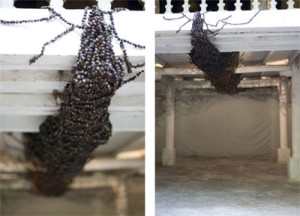
In Vietnamese, ‘longan’ is translated as ‘dragon’s eyes’ because of the fruit’s resemblance to an eyeball when it is shelled: the flesh is mucilaginous, whitish and translucent, while the seed is round, jet-black, shining, with a circular white spot at the base, giving it the aspect of an eye. By joining hundreds of seeds together to build the sculptures/installations for this exhibition, Duc has created an honest portrait of his hometown and his loved ones. The glossy lacquered black seeds stand for the eyes and souls of his family members, friends and farmers – working days and nights on the longan fields, worriedly looking out for the weather. Like many other agricultural products grown in Vietnam, the longan is very much dependent on the weather: blooming will be poor after a warm winter; the tree itself is very sensitive to frost and has irregular bearings – often one good year followed by one or two poor years; its ripening season is also the time of hard rain and typhoons… To produce the most fragrant and succulent longans is an extremely difficult task. There is even a Vietnamese saying: ‘Buôn long mã xấu’ (which generally means ‘Longan business is unlucky business’) to express the tough life of the longan farmers.
—
There’s a need to understand that it could be quite risky when artists use a kind of material too personal and figurative, and only reflects certain aspects of their own culture, background or experiences. A lot of the time the audience won’t be able to appreciate this, either because they only have a limited knowledge on the material or simply because they don’t share the same culture and background with the artist. However, Duc’s work doesn’t fall into this category. Although he did use a medium and experiences so private and close to his heart, the artist was able to tell not only his story, but also others’ – stories of those who left their hometowns and countries, aiming to build a better life elsewhere; stories about origins and roots; stories that remind us to always remember who we really are and where we come from. In other words, the artist is asking us to recall and share our own stories – we look at the artworks to look into ourselves. Consequently, the art becomes merely a trigger and a vehicle to create something much more valuable: a meeting place for both the eyes and the minds of the artist’s, the audience’s, of everyone’s.
The structures used in Duc’s sculptures/installations further reinforce this notion. As we enter the exhibition, we are confronted with a large and dominant piece in the centre of the space. Depending on how one observes and understands things, the work could be seen as a futuristic being – crawling out of a fictional movie, expanding itself from the ceiling to other parts of the room. It could also be read as a living organism – something that could be part of a structure of a DNA. Or it could be interpreted as one of the most celebrated and worshipped mythical creatures in the Vietnamese culture – the dragon. On closer inspection, we realize that there are two other works on both sides of the room: one seems to be poking out from behind a wall, the other appears as if it is forming a nest on one of the house columns. Together the three sculptures/installations make up an impressive continuous artwork. One that seems to be existing, growing, emerging, developing – a process of transference, of being-in-Motion, of Being in-motion, of be-com-ing and of coming-to-be.
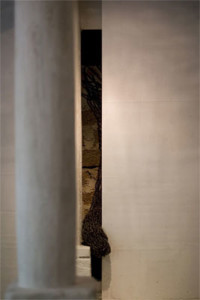
Whatever the work’s prescribed meaning was, and whatever the artist was trying to achieve with it, we still have to give him credit for having created not only a visually interesting piece, but also one that has the ability and strength to challenge the normally powerful and overshadowing Nha San. Rather than producing a work for the site, Duc has treated and used this space as a primary ingredient of the work’s content. Nha San becomes part of the work (and not the cause) and in return, the work becomes an alteration, intrusion and extension to the architecture of this space. A relationship is then established between the site and the artwork, which in turn brings about changes in our contextual views and perceptions, and challenges the definitions and etiquettes of both the place and the placed.
As we walk around, we realize how well Duc has intervened and interacted with the architectural structures of this place. He has used the ‘spare’ and ‘forgotten’ spaces as the foundation for his works: behind a wall, a corner, a house column, holes and gaps on the ceiling and on the wall. This aspect of Duc’s work reminds me of Victor Hugo’s famously coined term ‘terrains vagues’ – those empty, unoccupied and abandoned border-areas between nature and civilization, between one realm and another. They are places of uncertainty and unease, places to be avoided. On the other hand, these are places full of creative potential and interest, being free from many of the restrictions elsewhere. There is something quite romantic when reading Duc’s work in this manner. It seems the artist is trying to bridge spaces of the real and some other world that lies just behind it. He is asking us to forget all the sadness and obscurities of life, to stop for awhile and come together as one, to share, perform and interact with one another – as do the organs and muscles and skeleton of a solitary body. And finally he is asking us to all overstep a limit, to transgress a border, to enter a land full of freedom, expectancies, promises, and possibilities – a eutopia [4].
[1] A general term used to define all kinds of wooden houses built on stilts, with columns and two floors.
[2] nhasanduc.multiply.com/
[3] www.nyartsmagazine.com/index.php?option=com_content&task=view&id=2180&Itemid=698
[4] A positive utopia, different in that it means ‘perfect’ but not ‘fictional’.
![]()
| Bill Nguyen is a fine arts graduate from Nottingham Trent University, England. He has recently returned to Hanoi and writes on contemporary art in Vietnam. |
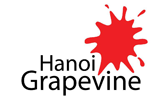

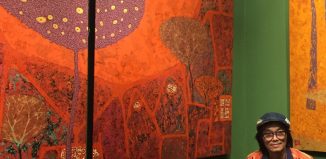














Tôi thấy tác giả hơi thái quá khi khen Nhà sàn Đức. Giá trị nằm trong mỗi tác phẩm nghệ thuật. Làm gì đến mức phải “cúi đầu ngưỡng mộ”?!
Long ạ,câu này mình thích nhất trong bài “Cả người thực hành nghệ thuật lẫn người thưởng thức nghệ thuật cần phải hiểu rẳng: khi nghệ sĩ sử dụng một chất liệu có tính hình tượng và cá nhân cao, và chỉ phản ánh những khía cạnh nhất định của nền văn hóa, bản sắc và trải nghiệm của riêng họ, thì người nghệ sĩ đó đang khá mạo hiểm.”Triển lãm của Hoàng Minh Đức hay, hay ngay từ lần đầu tiên.Cám ơn bài viết khá sâu và khá hiểu cả :tác giả, tác phẩm lẫn khán giả.Cám ơn Nhà Sàn Đức đã tổ chức triển lãm này.
To Hoa Nguyen: nick của bạn này bị trùng với nick của tớ đã đăng kí.Mình là Nguyễn Thanh Hoa, thành viên sáng lập của nhóm nghệ sỹ HanoiLink.Nick này để liên lạc và sử dụng trên hanoigrapevine đã lâu.Nếu không phiền , bạn có thể đổi hoặc thêm dấu tên đầy đủ của bạn để tránh nhầm lẫn , nhất là khi phát biểu ý kiến trên này.Cảm ơn.